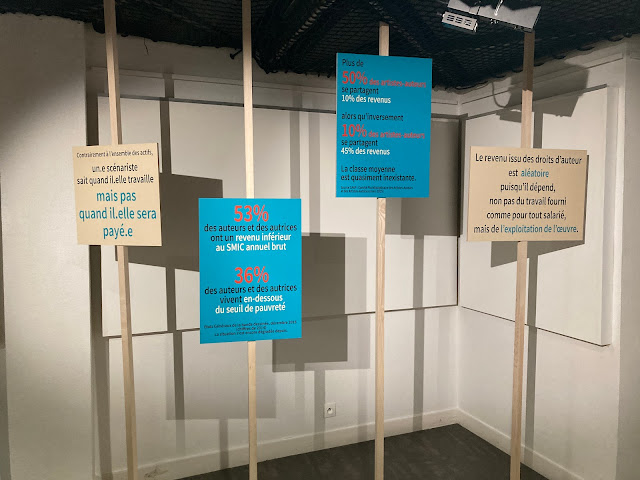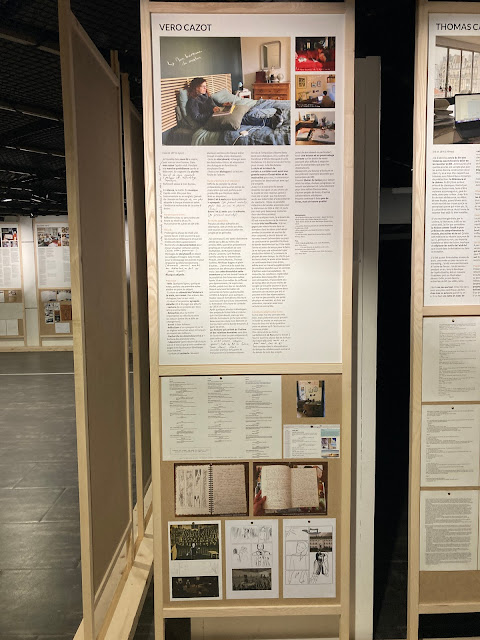by Martha Kennedy
 |
| Self-Portrait, c.2017 © Jim Morin |
Jim Morin: Drawing and Painting. Martha H. Kennedy. Ogunquit, Maine: Ogunquit Museum of American Art, May 1 – October 31, 2022. <https://ogunquitmuseum.org/exhibition/jim-morin-drawing-and-painting>
Ed. Note – When it became apparent that we were not going to get a reviewer for this show in Maine, we asked the exhibit’s guest curator, Martha Kennedy to give us some background on creating the exhibit. A long-time contributor to IJOCA, she has recently retired as a curator from the Library of Congress’ Prints and Photographs Division.
The exhibition presents a selection of cartoon drawings and paintings by the artist that focus upon the environment and landscape. Best known as a highly acclaimed political cartoonist, Morin is also a very accomplished painter in oil. He stands out among his peers by connecting the artistic process of working in these two different media, noting “My paintings affect my drawings and vice versa...”
During more than four decades as the editorial cartoonist for the Miami Herald, Morin won two Pulitzer Prizes in 1996 and 2017, shared another with the Herald editorial board in 1983, received the Thomas Nast Society Award in 2000, the prestigious Herblock Prize in 2007, and many other honors and distinctions. While honing his talent and skill as a cartoonist, he made time to paint in the evenings and frequently exhibited his paintings from 1982 onward.
Born in Washington, D.C. in 1953, Morin grew up outside Boston, Massachusetts, in a family that discussed politics and encouraged him to draw. He graduated from Syracuse University with a major in illustration and a minor in painting. He studied the latter under Jerome Witkin, who “saw cartoons as paintings, as art.” This perspective played into Morin’s artistic development in that strong design characterizes both his cartoon drawings and his paintings. Morin worked at the Beaumont Enterprise and Journal and the Richmond Times-Dispatch before he became the editorial cartoonist for the Miami Herald, holding the position from 1978-2020.
Works in the exhibition are arranged in three sections. Cartoon drawings in “The Environment” reveal Morin’s ability to transform keen observations of the physical world into arresting imagery that captures changes in the earth’s atmosphere, threats to the well-being and diversity of fauna and flora, pollution of the oceans, deforestation, and other shifts in the environment. He has never shied away from pointing to the impact of varied human activity on the planet. As evidence of climate change has grown and become widely acknowledged by scientists and non-scientists alike since the late 1980s, his concern has only deepened, and his imagery become more alarming. Selections include several Pulitzer Prize-winning works and graphic commentaries on major environmental disasters including the oil tanker Exxon Valdez running aground and the explosion of British Petroleum’s Deepwater Horizon oil rig. In many other examples, he also decries how unchecked development of fossil fuels adversely affects the land and human well-being.
Another section of the show situates Morin’s drawings in the grand tradition of satirical art that arose and flourished largely in Britain and France from the late 18th into the 19th centuries. Leading artists of those times, such as James Gillray (1756-1815), Thomas Rowlandson (1756-1827), and Honoré Daumier (1808-1879), employed bold caricature in scenarios that critiqued the behaviors of leading public figures and governing bodies. Morin cites his study of Daumier’s work, both drawings and paintings, as a major influence in his artistic development. The tone and approach that he employs, for example, in caricaturing businessmen and politicians as squat, rounded figures, sinister and smugly smiling as they wield power for dubious ends, remind one of Daumier, who won lasting acclaim for his biting portrayals of the deceitful and powerful.
Additional qualities that often characterize Morin’s cartoons include boldly designed compositions, varied points of view, and fine, often meticulous rendering of forms regardless of size, all perfectly balanced. Many of these qualities also distinguish his paintings. Although Morin paints a wide variety of subjects including landscapes, cityscapes, and human figures, this exhibition primarily features landscapes, which include no people. Recent examples, in particular, possess a strong sense of place underlaid by keen observation and love of nature. His paintings often feature changing atmospheric conditions and light effects in the sky and on the water, in addition to reflecting his fascination with approaching storms. Since 2013, he has chosen to live in Ogunquit with his wife Danielle Flood, a writer. He celebrates the natural beauty of the area and finds inspiration in walking, kayaking, and viewing the ocean from his house, and seeing what he calls “a daily miracle.”
Jim Morin will discuss his work in conjunction with the exhibition, following a brief introduction of the artist by curator Martha Kennedy at the Ogunquit Museum of American Art on Tuesday, July 5th, from 5-7 p.m. The exhibition is generously sponsored by the Miami Herald.
























































